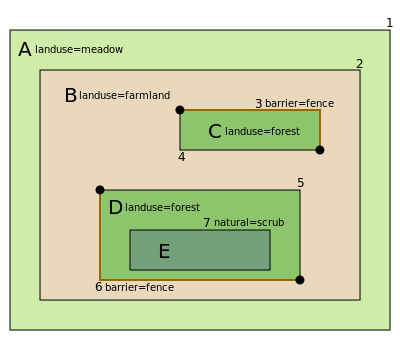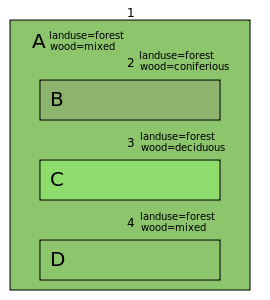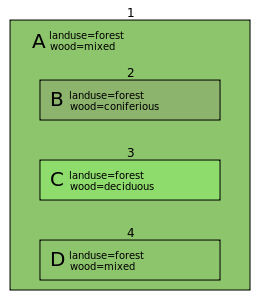FR:Multipolygon Examples
Cette page propose des exemples réels des relations de type multipolygone.
Liste de plusieurs exemples pour les mappers : Étape par étape, du plus simple au plus complexe
Dans ce chapitre, un exemple simple est expliqué jusqu'à devenir progressivement un exemple considéré comme complexe.
Nomenclature pour décrire les exemples :
Relation Tag pour la Relation ... Membre de la Relation >Nouveau membre de la Relation ... |
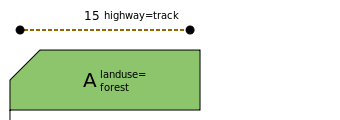 |
Forêt (Un seul chemin fermé)
Le chemin fermé numéro 1 est dessiné et étiqueté avec landuse=forest décrivant la forêt A. Marquer un chemin fermé avec une étiquette indiquant une zone entraîne le dessin d'une zone. Ce type de raccourci fonctionne pour des zones simples dont le contour consiste en un seul chemin et qui n'ont pas de trous. La même chose pourrait être faite avec un multipolygone, mais cela ne ferait que complexifier un cas simple.
|
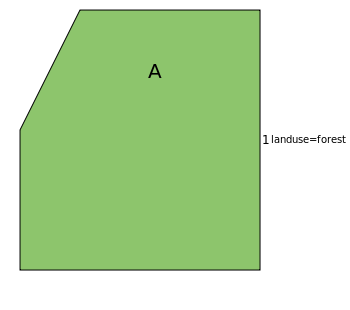 |
Forêt ayant un lac (Un lien outer ainsi qu'un lien inner)
Le chemin fermé numéro 2 est ajouté à l'intérieur de la forêt A et étiqueté avec natural=water décrivant le lac B. Le chemin fermé numéro 1 n'est plus balisé car il n'y a pas de caractéristiques cartographiques pour l'ensemble de la zone fermée. Cela ne représente pas réellement quelque chose. La forêt A qui est étiquetée landuse=forest est le lien vert : la zone délimitée par le chemin numéro 1 moins le lac B.
Le multipolygone A décrit le cas. Relation A: type=multipolygon landuse=forest outer 1 inner 2 |
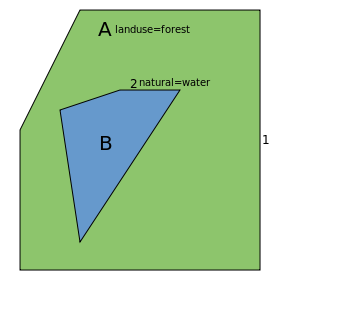 |
Forêt ayant deux lacs (Un outer ainsi que deux liens inner)
Le chemin fermé numéro 3 est ajouté dans la forêt A et est étiqueté avec natural=water décrivant le lac C. La forêt A qui comporte l'étiquette landuse=forest n'est donc pas un simple lien. Elle est maintenant la zone délimitée par le chemin 1 moins les lacs B et C.
inner 3 est ajouté au multipolygon A : Relation A: type=multipolygon landuse=forest outer 1 inner 2 >inner 3 |
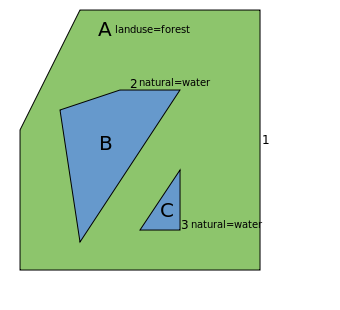 |
Forêt avec deux lacs ainsi qu'une île (Multipolygones imbriqués)
Chemin fermé numéro 4 est ajouté dans le lac B et étiqueté avec natural=scrub décrivant l'île D.
La forêt A et donc le multipolygone A restent inchangés : Relation A: type=multipolygon landuse=forest outer 1 inner 2 inner 3 Le chemin fermé numéro 2, à présent, ne possède plus son étiquette car il n'y a plus d'entités cartographiques pour toute la zone fermée. Lac B est étiqueté avec Ceci est décrit par un second multipolygone B : Relation B: type=multipolygon natural=water outer 2 inner 4 |
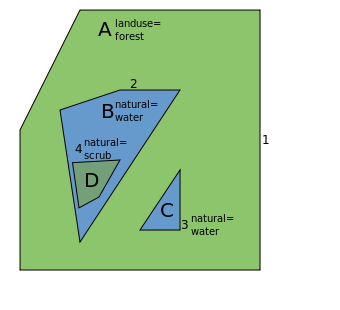 |
Forest with 2 lakes, island, boundary and highway (Multiple ways forming nested multipolygons)
Way 1 used to be the whole boundary of forest A now gets split and partially replaced: The linear ways 5, 6, 7 and 8 are added and tagged with boundary=administrative. Further the linear ways 9, 10 and 11 are added and tagged with highway=unclassified.
Remark: the usage of highways (linear element) as boundaries (multipolygon or not) for landuse (area element) is basically discouraged. This because later shifting, nudging or reshaping the highway or area immediately results in the not often intended change of the connected area resp. highway. More importantly the vast majority of (less technical) mappers cannot be expected to ever grasp advanced multipolygons. Overusing advanced multipolygons like in this example will either prevent those mappers from participating or down the road guarantee the destruction of these multipolygons. Also note that including highways in advanced multipolygons like in this example, vastly complicates later editing of those highways (physical modifications to roads happen all the time). Far from all mappers can be expected to have the skills or time to handle this gracefully. Way 2 used to be the whole boundary of lake B is also split. The ways 12, 13, 14 and 15 are added and tagged with The "remaining" way 1 and the ways 6 and 10 are now forming the boundary of forest A. outer 6, outer 10 and inner 13 are added to multipolygon A: Relation A: type=multipolygon landuse=forest outer 1 >outer 6 >outer 10 inner 2 >inner 13 inner 3 The ways 2 and 13 are forming the boundary of lake B. outer 13 is added to multipolygon B: Relation B: type=multipolygon natural=water outer 2 >outer 13 inner 4 |
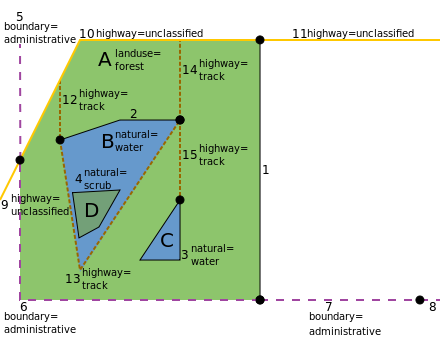 |
Remarks:
- When a highway is chosen as boundary of an area then the roadside and not the (imaginary) center line of the road is the boundary.
- Some mappers prefer to use ways as boundaries of areas as in this example, some prefer drawing separate lines and some use both depending on the situation.
- This sequence of examples started with areas. In practise it's more likely to have linear features like highways before areas are added.
Farmland adjacent to forest and farmyard adjacent to lake (Adjacent multipolygons and adjacent inner areas)
The former way 1 gets split again into a new short way 1 and a new way 16 which is tagged with barrier=fence. Way 17 is added and tagged with barrier=fence. Way 18 is added and not tagged. Ways 7, 16, 17 and 18 are forming the boundary of farmland E which is adjacent to forest A. They share the way 16. Closed way 19 is added inside farmland E and tagged with landuse=farmyard describing farmyard G. Closed way 20 is added by using the two northern nodes of way 19 and drawing a duplicate way on top of the northern boundary of farmyard G. Way 20 is tagged with natural=water describing a third lake F.
outer 16 is added to multipolygon A: Relation A: type=multipolygon landuse=forest outer 1 >outer 16 outer 6 outer 10 inner 2 inner 13 inner 3 Multipolygon B stays unchanged: Relation B: type=multipolygon natural=water outer 2 outer 13 inner 4 Farmland E is described by a new multipolygon E: Relation E: type=multipolygon landuse=farmland outer 7 outer 16 outer 17 outer 18 inner 19 inner 20 |
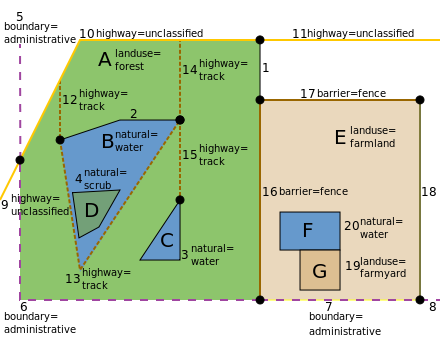 |
Remarks:
- Duplicate ways, i.e. ways on top of each other, are acceptable, duplicate nodes, i.e. nodes on each other, not.
- Duplicate ways can be avoided by using multipolygons. But in this example it would just complicate a simple case.
Three separated farmland (Disjunct outer rings)
Way 21 is added and not tagged. Way 22 is added and tagged with barrier=fence. Way 21 and 22 are forming farmland E2 which is separated from but belongs to farmland E.
Way 23 is added and not tagged. Way 24 is added and tagged with Multipolygon A stays unchanged: Relation A: type=multipolygon landuse=forest outer 1 outer 16 outer 6 outer 10 inner 2 inner 13 inner 3 Multipolygon B stays unchanged: Relation B: type=multipolygon natural=water outer 2 outer 13 inner 4 outer 21, outer 22, outer 23, outer 24 and inner 25 are added to multipolygon E: Relation E: type=multipolygon landuse=farmland outer 7 outer 16 outer 17 outer 18 inner 19 inner 20 >outer 21 >outer 22 >outer 23 >outer 24 >inner 25 |
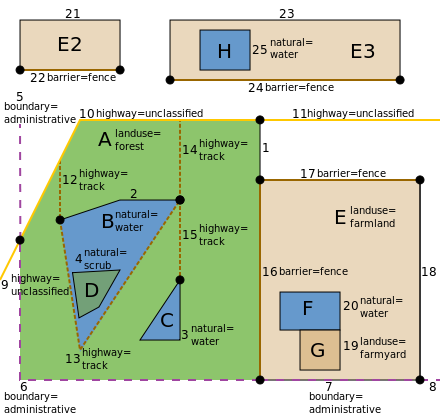 |
Examples for mappers
Meadow with farmland with two forest with scrub (Polygons nested 4 levels)
Rule: When polygons are nested over several levels it's the safest way to
- tag only the most inner closed ways with tags describing an area and
- tag the other closed ways only in such a way that no area is described and
- use multiple multipolygons each describing two adjacent levels.
This example originated from the discussion Verschachtelte Multipolygone in the forum Germany.
Forest with three wood
This example originated from the discussion Multipolygone, z.B. See oder Gebäude in Waldfläche in the forum Germany. It demonstrates how current deficiencies of the renderers in processing multipolygons can be circumvented while still tagging correctly according to the reality. No Tagging for the renderer.
Theory:
Practice:
